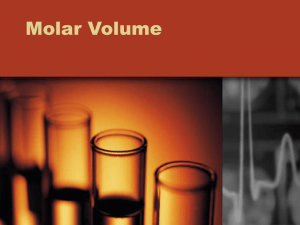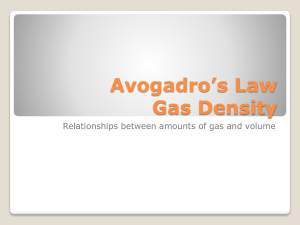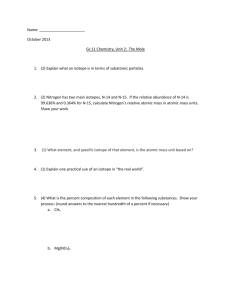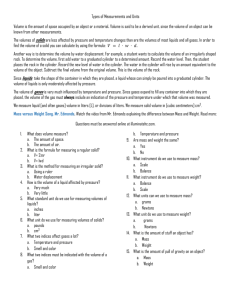Gas Laws Lab Experiment: Boyle's, Charles', Avogadro's Laws
advertisement
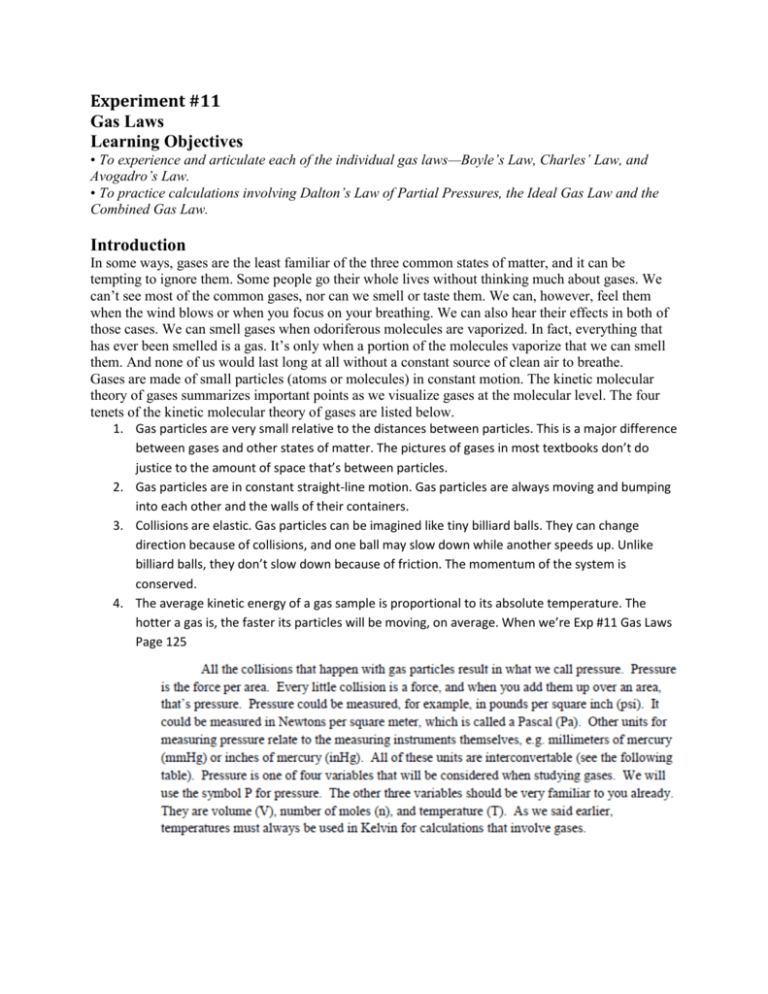
Experiment #11 Gas Laws Learning Objectives • To experience and articulate each of the individual gas laws—Boyle’s Law, Charles’ Law, and Avogadro’s Law. • To practice calculations involving Dalton’s Law of Partial Pressures, the Ideal Gas Law and the Combined Gas Law. Introduction In some ways, gases are the least familiar of the three common states of matter, and it can be tempting to ignore them. Some people go their whole lives without thinking much about gases. We can’t see most of the common gases, nor can we smell or taste them. We can, however, feel them when the wind blows or when you focus on your breathing. We can also hear their effects in both of those cases. We can smell gases when odoriferous molecules are vaporized. In fact, everything that has ever been smelled is a gas. It’s only when a portion of the molecules vaporize that we can smell them. And none of us would last long at all without a constant source of clean air to breathe. Gases are made of small particles (atoms or molecules) in constant motion. The kinetic molecular theory of gases summarizes important points as we visualize gases at the molecular level. The four tenets of the kinetic molecular theory of gases are listed below. 1. Gas particles are very small relative to the distances between particles. This is a major difference between gases and other states of matter. The pictures of gases in most textbooks don’t do justice to the amount of space that’s between particles. 2. Gas particles are in constant straight-line motion. Gas particles are always moving and bumping into each other and the walls of their containers. 3. Collisions are elastic. Gas particles can be imagined like tiny billiard balls. They can change direction because of collisions, and one ball may slow down while another speeds up. Unlike billiard balls, they don’t slow down because of friction. The momentum of the system is conserved. 4. The average kinetic energy of a gas sample is proportional to its absolute temperature. The hotter a gas is, the faster its particles will be moving, on average. When we’re Exp #11 Gas Laws Page 125 Atmosphere (atm) Millimeters of Mercury (mmHg) Torr (torr) Pascal (Pa) Kilopascal (kPa) Bars (bar) Inches of Mercury (inHg) Pounds per Square Inch (psi) 1 atm (exactly) 760 mmHg (exactly) 760 torr (exactly) 1.01325 x 105 Pa 101.325 kPa 1.01325 bar 29.92 inHg 14.7 psi There are relationships between all four of the variables for gases. If we allow only two variables at a time to fluctuate, and hold the other two variables steady, we have what are known as the individual gas laws. Boyle’s law gives a relationship between volume and pressure. Charles’ law gives a relationship between temperature and volume. Avogadro’s law gives a relationship between the number of moles of the gas and the volume. Understanding the individual gas laws is really good for developing your chemical intuition. That’s why you’ll often see lots of test questions that don’t really require your calculators when it comes to these. Instead of telling you what these gas laws state, today’s experiments are designed to help you articulate the relationships in the individual gas laws. Gas Law Boyle’s Charles’ Avogadro’s Combined Ideal Variables that Fluctuate P, V V, T n, V P, V, T P, V, n, T Variables that are Constant n, T P, n P, T n R (the gas constant) The resulting formula for each of the above laws. Boyle’s P1V1 = P2V2 Charles’ V1 𝑇1 = V2 𝑇2 Avogadro’s There are two gas laws that we will work with quantitatively in today’s experiments. They are the Combined Gas Law, and the Ideal Gas Law. These both take relationships shown in the individual gas laws and combine them all together. Since we will be doing calculations with these, don’t forget to use Kelvin temperatures throughout. With scientists around the world working at different locations with different altitudes, weather patterns, and temperatures, it is handy to have an agreed upon reference point to which everyone can normalize their data. Otherwise, it would be difficult to know how results here in Twin Falls in the winter with a storm approaching compare with results in the Netherlands on a summer day just after a storm. The internationally agreed upon reference point is called Standard Temperature and Pressure (STP). STP is defined as 0°C or 273 K and exactly 1 atm. Another reason that STP is handy is that when an experiment uses STP, (and only when an experiment uses STP) there is a conversion factor between volume and moles that can be used, called the STP molar volume. One mole of gas occupies 22.4 L at STP. Knowing this can often save you several steps while solving a problem. The last point that we need to understand for today’s lab involves mixtures of gases. Everything that’s been said thus far applies to both mixtures and pure samples of gases. With mixtures, though, it’s possible to talk about partial pressures. Take air as an example. It is about 78% N2, 21% O2, and 1% other gases. 78% of the collisions, and therefore 78% of the pressure is coming from N2 particles. Similarly, 21% of the collisions and therefore 21% of the pressure is coming from O2. If the total air pressure is 1.00 atm, then the pressure of N2, P(N2), is 0.78 atm, and the pressure of O2, P(O2), is 0.21 atm. Dalton’s Law of Partial Pressures tells us that the total pressure of a mixture of gases is the sum of the individual gas pressures. Ptot = P1 + P2 + P3 + … We will use partial pressures today when we collect a gas over water. Most of the gas that’s collected will be the hydrogen or carbon dioxide gas that is generated by a chemical reaction, but a portion of the gas will be water vapor. The amount of water vapor is dependent only on the temperature (see table below). We will need to account for the P(H2O) so that what we’re using in our calculations really reflects P(H2), not P(H2 + H2O). It is important to realize that there is no such thing as partial volumes. All the gases are going to move around and occupy the whole volume. Special Safety Concerns Exercise caution with strong acids. Don’t burn yourself with the hot soda pop can or hot plate. Make sure that you do the pre-lab before you start the lab. A. Boyles law 1. Get your materials. You’ll need a syringe from the side shelf. 2. Vary the volume and experience the effect on pressure. Using your thumb or finger at the tip of the syringe to feel the pressure, investigate what happens when you decrease the volume of gas in the cylinder of the syringe. (Start with the piston out, and then move it in.) What do you feel on your thumb if your increase the volume of the gas in the cylinder of the syringe? 3. Answer the following question: 4. A1. Restate Boyle’s Law, using the syringe to illustrate. 5. A2. Define the word vacuum in terms of pressure. B. Charles’ Law 1. Get your materials. You will need an empty soda pop can, a hot plate, a 400 or 600 mL beaker or equivalent filled ~2/3 with ice bath, beaker tongs, and a thermometer. Put about 10 mL of water in the soda pop can. An ice bath is about half and half ice and water. Ice should extend to bottom of container and water should extend to the top. 2. Determine a method for calculating the volume of the can empty. 3. Make some hot gas. Heat the soda pop can on the hot plate until the water inside is boiling. You may assume that the steam inside is at 100 ºC. While you’re waiting, measure the temperature of your ice bath. 4. Change the temperature of the gas. Using your beaker tongs, quickly invert the soda pop can Into the ice bath. Record your observations. 5. Use the same method as you used before to calculate the volume of the empty can and find volume of the can after the temperature of the gas changes. Write down the answers for this in your notebook. B1. Restate Charles’ Law using your experiment as an example. C. Avogadro’s Law 1. Get your materials. From your drawer, you’ll need three test tubes, marked as #1, #2, and #3, and your funnel. You’ll need three small balloons, about 15 mL of vinegar from the side shelf. Measure 0.10 g of baking soda (NaHCO3) into test tube #1, 0.20 g of baking soda (NaHCO3) into test tube #2, and 0.40 g of baking soda (NaHCO3) into test tube #3. 2. Prepare the balloons with vinegar. Stretch each of your balloons about ten times. Use your funnel to put about 5 mL of vinegar into each balloon. Keeping the vinegar solution at the bottom of the balloon, stretch the neck of the balloon around the rim of the test tube. The balloon and vinegar should be sagging down beside the test tube. You should have a tight fit between the balloons and the test tubes. If not, you’ll need to switch to larger test tubes that your instructor could provide. 3. Initiate the reaction and record results. Once all the test tubes are ready, begin the reaction by lifting the balloon above the test tube, so that the vinegar pours down and into the test tube. Record your observations. Questions to Answer in the “Questions” Section of your Notebook: C1. Restate Avogadro’s Law, using your experiment to illustrate. C2. How many moles of CO2 gas are expected from each of the reactions? D. Ideal Gas Law and Combined Gas Law 1. Get your materials. You’ll need a 400 or 600 mL beaker and the 100 mL graduated cylinder from your drawer. From the side benches, you’ll need a single piece of magnesium ribbon that’s 0.05 g or less (record its exact mass), and a long-stemmed funnel. In the hood, you’ll need to get about 50 mL of 6 M HCl. You’ll also need a small piece of paper towel. 2. Prepare your gas collection apparatus. Remove all the plastic rings and bases from the graduated cylinder. Fill your beaker about 1/2 full with room temperature distilled water. Fill your graduated cylinder all the way to the rim with room temperature distilled water. Do all the rest of this over the sink. Cover the top of the cylinder with a bit of paper towel. Holding your fingers over the paper towel, invert the cylinder and lower it into the beaker of water. If you have any air bubbles in the cylinder, you’ll need to start over. There’s no reason to waste all the water, though. Drain it into the beaker, and then fill the cylinder from the beaker. Once you’ve successfully gotten a water-filled cylinder overturned into the beaker, you can fish the bit of paper towel out of the water. 3. Start your reaction. Drop your piece of magnesium into the beaker. Maneuver the mouth of the cylinder until it is over the metal. Use your long-stem funnel to add the acid, directing it towards the lip of the cylinder. 4. Complete the reaction and record results. Catching all the bubbles from the reaction is the hard part of this experiment. If your metal breaks apart and comes out from under the cylinder, then you are no longer collecting all the gas and you’ll need to start over. If you succeed in collecting all the gas, then measure the volume of gas using the markings on the cylinder. 5. Collect environmental data that will be needed. You’ll need to know the atmospheric pressure and temperature for the lab on the day of the experiment. Record the room temperature. Record the barometric pressure. Look at the barometric reading on national oceanic and atmosphere agency. Questions to Answer in the “Calculations” Section of your Notebook: D1. Perform your calculations to verify the ideal gas law. a. Use the table on page 4 and T (room temp) to find the P(H2O). b. Use Dalton’s Law of partial pressures, the barometric pressure, and the P(H2O) to calculate the P(H2). c. Use the Ideal Gas Law with P(H2), V(H2), T(H2) (equal to room temp) and the gas constant R to calculate the moles of hydrogen, n(H2). d. Using the balanced chemical equation, do some Stoichiometry to calculate the moles of magnesium. e. Combine your mass of magnesium with the moles of magnesium to determine the molar mass (grams/mole). f. How does your result compare with the known molar mass of magnesium? What might account for any differences? D2. Perform your calculations to verify the molar volume of a gas at STP. a. Use the combined gas law with P(H2), V(H2), T(H2), P(STP), and T(STP) to calculate V(STP). This is the volume that your gas would occupy at STP conditions. b. Combine V(STP) with n(H2) (above) to figure the molar volume at STP (L/mol). c. How does your result compare to the expected STP molar volume of 22.4 L/mol? What might account for any differences? Prelaboratory Assignment 1. Which two variables are compared in Charles’ Law? 2. Which two variables are compared in Boyle’s Law? 3. Which two variables are compared in Avogadro’s Law? 4. Define the following terms—pressure, STP, partial pressure, molar volume. 5. Convert 654 mmHg into atmospheres? 6. Temperatures for gas calculations must always be in Kelvin. What is 23°C in Kelvin? Postlaboratory Assignment 1. Which of the following best describes Boyle’s Law? 2. Which of the following best describes Charles’ Law? 3. Which of the following best describes Avogadro’s Law? Questions 4 – 8 all refer to the following experiment. A student performed an experiment in the same manner as part D (magnesium + HCl). The temperature for the day was 22 °C and the barometric pressure was 742 mmHg. 43.5 mL of gas was collected. 4. What is the partial pressure of the hydrogen gas (in atm)?Exp #11 Gas Laws Page 132 5. How many moles of hydrogen gas were formed? 6. How many grams of magnesium must have been used in the reaction? 7. What would have been the volume of collected gas if the experiment were done at STP? 8. What would have been the volume of collected gas if the experiment were done at 4.73 atm and 57.0°C?


